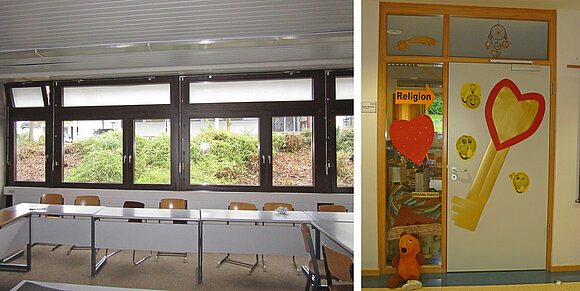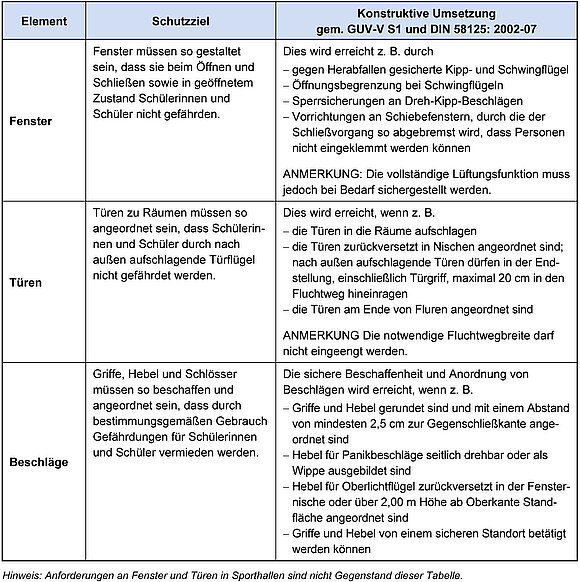Reading time: 1 minute
What makes a building special? The building regulations classify special buildings as rooms and facilities of special type or use.

This is given concrete shape in the sample building code and the respective national building regulations by a list of different types of buildings. Typical examples are: skyscrapers, meeting places, hospitals and even schools, universities and similar facilities. For some of these approximately 20 special constructions listed, there are special codes existing such as, for example: the meeting place ordinance, regulations for residential facilities and the sample school building guidelines.
What is common in these regulations is that they usually – if at all – provide only rudimentary specifications for the requirements of windows and doors. Often, this is only related to closures or shutters of rescue routes. Thus, the designer barely has any clue or guiding principle on the properties required of these elements. In other words: There is no relation to the classifications as they are provided in abundance in the product standard EN 14531-1.
This is just as annoying as it is unfortunate, since, as in the case of school buildings, the user group is known and thus, you can respond to the special needs and loads. This means that potential problems can be confronted effectively right at the design and planning stage by selecting suitable constructions. The as-built reality, however, is another, which is demonstrated by a considerable rise in complaints and damages involving windows and doors in schools. The following is meant to trigger thought processes that need to be taken into consideration in the course of design and execution.
Typical groups of problems
It is necessary to be aware of the expected loads and stresses for specifying suitable constructions. Basically, it can be seen that a very "robust utilisation" of windows and doors prevails in schools. The high level of loads and stresses are usually not posed by human beings who are constantly engaged there but by the attendees – the students – and therein, particularly children and youngsters. Depending on the type of school, the characterisation of the loads and stresses may vary considerably. In addition, they depend on the type and usage of the rooms. These include:
- Common areas and classrooms (students, at times unsupervised)
- Specialist rooms such as those for physics, chemistry, music, etc. (generally supervised)
- Rooms in sports halls
- Administrative and other rooms
Based on the sometimes extremely frequent use and the wrong operations / misuse resulting from operation by children and youngsters that cannot be avoided (keyword: jamb impact) problems frequently arise with respect to the mechanical strength. Other typical issues, defects and damages pertaining to windows and doors in schools may be summarised as follows (in the process, the focus is primarily on the elements installed in classrooms):
- Mechanical damages and quality of mechanical hardware
- Operating forces and functional durability
- Load-bearing safety mechanism and safety of use
- Room climate (window-related issues such as sunshades, glare, ventilation …)
- Freedom from barriers
- Sound insulation
- Safety with "running amok", extended suicide (doors)
Specifications have been laid down in numerous regulations in order to confront these issues effectively.
Requirements
Notes on construction-related design of school buildings have been provided in various regulations. The GUV-V S1 of the German Statutory Accident Insurance e.V. (registered association) (DGUV) [1] and DIN 58125) [2] for the development of windows and glazing deserve special mention. This formulates protection objectives and describes constructive guidelines for this purpose. Table 1 contains extracts of such requirements or protection objectives. From this it is evident that there are relatively concrete construction-related specifications existing for schools other than those for other special constructions.

Tips for implementation
Table 1 provides tips on constructive implementation of the protection objectives formulated that are primarily aimed at safety of use. In general: The better the user group is known, the better can windows and doors be designed to meet their needs and requirements. For purely primary schools (keyword, operating height and force) or sponsored schools for cognitively handicapped students (keyword easy, identical and recognisable operation), this is quite possible. The special requirements can be taken into consideration:
A few general tips for windows and doors in schools are listed as bullets in the following:
- Simple constructions with robust design details
- Suitable types of opening
- Large-sized panels and sashes to be avoided
- High mechanical strength (high level of functional durability and mechanical strength classes), and if necessary, use of certified hardware technology for turn / tilt fittings of windows / balcony doors in accordance with QM 328
- Use of fixed glazing where possible
Nonetheless, regular inspection, care and maintenance are indispensable in order to guard against severe restrictions on use and hazards. The involvement and training of the building caretaker locally is an important component.
Outlook
For special constructions such as schools, there are a whole range of regulations with protection objectives. However, this is rarely of assistance to the designer when specifying properties for tendering purposes. The reference to the performance classes specified in the product standard EN 14351-1 is missing. The new "Rosenheim Guidelines" are now meant to bridge this gap for special constructions.
One by one, this series of guidelines is meant to illustrate significant correlations between designing, fitting and execution of windows and doors for different special constructions, and to demonstrate the circumstances of use as well as the necessary maintenance and care. The result is a recommendation [3] for use with classifications/values according to the performance characteristics of the product standard. This shall provide an orientation aid for preparing unambiguous tender specifications to those involved in the construction.
Literature
- GUV-Vorschrift 81
Unfallverhütungsvorschrift Schulen (accident prevention regulation at schools)
Deutsche Gesetzliche Unfallversicherung e.V. (German Statutory Accident Insurance; registered association) (DGUV)
Berlin - DIN58125 : 2002-07
Construction of schools - Constructional requirements for accident prevention
Beuth Publishing GmbH - ift-Richtlinie FE 16/1
Einsatzempfehlung für Fenster in Schulbauten
ift Rosenheim, September 2015
(only available in german)


